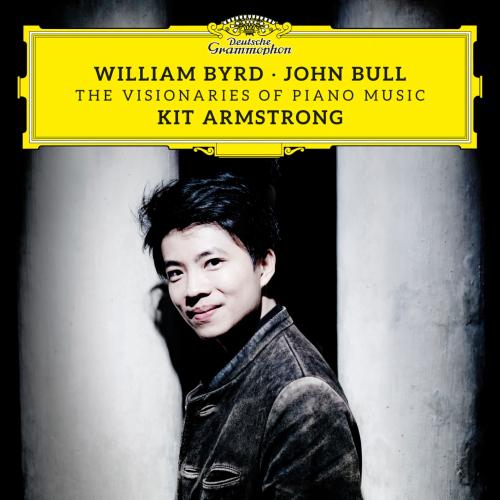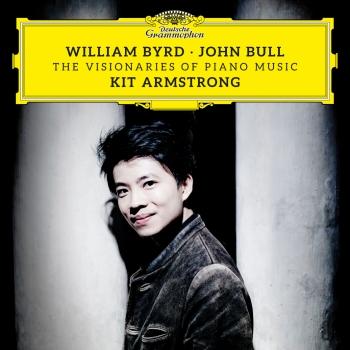
William Byrd & John Bull: The Visionaries of Piano Music Kit Armstrong
Album info
Album-Release:
2021
HRA-Release:
09.07.2021
Label: Deutsche Grammophon (DG)
Genre: Classical
Subgenre: Instrumental
Artist: Kit Armstrong
Composer: William Byrd (1543-1623), John Bull (1562-1628)
Album including Album cover Booklet (PDF)
I`m sorry!
Dear HIGHRESAUDIO Visitor,
due to territorial constraints and also different releases dates in each country you currently can`t purchase this album. We are updating our release dates twice a week. So, please feel free to check from time-to-time, if the album is available for your country.
We suggest, that you bookmark the album and use our Short List function.
Thank you for your understanding and patience.
Yours sincerely, HIGHRESAUDIO
- William Byrd (1540 - 1623):
- 1 Byrd: Prelude (Parthenia 1; MB 27/1) 00:40
- 2 Byrd: Pavan “Sir William Petre” (Parthenia 2; MB 27/3a) 04:42
- 3 Byrd: Galliard (Parthenia 3; MB 27/3b) 02:33
- 4 Byrd: The Battle (Nevell 4; MB 28/94): The Flute and the Drum 01:48
- 5 Byrd: The Woods so Wild - 14 Variations (Fitzwilliam 67; MB 28/85) 03:37
- 6 Byrd: The Maiden's Song - 8 Variations (Fitzwilliam 126; Nevell 28; MB 28/82) 05:32
- 7 Byrd: John Come Kiss Me Now - 16 Variations (Fitzwilliam 10; MB 28/81) 05:22
- John Bull (1562 - 1628):
- 8 Bull: Fantasia (Fitzwilliam 108) 03:58
- 9 Bull: Fantastic Pavan (Fitzwilliam 34; MB 19/86a) 04:43
- 10 Bull: Fantastic Galliard (Fitzwilliam 35; MB 19/86b) 01:37
- 11 Bull: Canons 51 - 48 - 39 - 7 - 15 - 114 (ÖNB Mus. Hs. 17771) 03:40
- 12 Bull: Prelude "Laet ons met herten reijne" (MB 14/56; BL Add. MS 23623 f. 65) 01:02
- 13 Bull: Carol "Laet ons met herten reijne" (MB 14/56; BL Add. MS 23623 f. 65) 02:04
- 14 Bull: Les Buffons - 15 Variations (MB 19/101; BL Add. MS 23623 f. 22) 03:21
- 15 Bull: Walsingham - 30 Variations (Fitzwilliam 1; MB 19/85) 13:13
- William Byrd:
- 16 Byrd: Pavan “The Earl of Salisbury” (Parthenia 6; MB 27/15a) 02:03
- 17 Byrd: Galliard (Parthenia 7; MB 27/15b) 01:17
- 18 Byrd: Second Galliard “Mris Marye Bronwlo” (Parthenia 8; MB 27/15c) 03:36
- 19 Byrd: The Bells (Fitzwilliam 69; MB 27/38) 06:08
- John Bull:
- 20 Bull: Queen Elizabeth’s (Chromatic) Pavan (MB 19/87a) 04:34
- 21 Bull: My Grief (Fitzwilliam 190; MB 19/139) 01:55
- William Byrd:
- 22 Byrd: O Mistress Mine - 6 Variations (Fitzwilliam 66; MB 28/83) 04:28
- 23 Byrd: The Second Ground - 16 Variations (Nevell 30; MB 27/42) 07:08
- John Bull:
- 24 Bull: Prelude (Fitzwilliam 43) 01:44
- 25 Bull: Melancholy Pavan (MB 19/67a) 04:13
- William Byrd:
- 26 Byrd: The Earl of Oxford’s March (Fitzwilliam 259; Nevell 3; MB 28/93) 03:11
- 27 Byrd: Ut, re, mi, fa, sol, la - Fantasia (Fitzwilliam 101; Nevell 9; MB 28/64) 06:31
- 28 Byrd: Ut, mi, re - Fantasia (Fitzwilliam 102; MB 28/65) 04:54
- John Bull:
- 29 Bull: Canons 68 - 78 - 79 - 65 - 3 - 53 (ÖNB Mus. Hs. 17771) 03:28
- William Byrd:
- 30 Byrd: Walsingham - 22 Variations (Fitzwilliam 68; Nevell 31; MB 27/8) 08:51
- 31 Byrd: Sellinger's Round - 9 Variations (Fitzwilliam 64; Nevell 37; MB 28/84) 04:19
- John Bull:
- 32 Bull: Fantasia on a Fugue of Sweelinck (MB 14/4; BL Add. MS 23623 f. 52) 03:53
- 33 Bull: Telluris ingens conditor: Nos. 1, 2, 3, 6, 7 (MB 14/47; BL Add. Ms 23623 f. 170) 05:03
Info for William Byrd & John Bull: The Visionaries of Piano Music
Kit Armstrong’s debut album on DG. Exploring a remarkable legacy of works originally written for organ or the virginal – close relative of the harpsichord – William Byrd · John Bull – The Visionaries of Piano Music presents pieces that were conceived as much more than diversions for an elite or adornments to ritual, span everything from meditative elegies and rousing marches to virtuoso variations on popular melodies and Bull’s ingenious canons.
Pianist and composer Kit Armstrong steps back in time to revive the spirit of the early English composers William Byrd and John Bull in his Deutsche Grammophon debut album. In the notes that accompany the double-disc album, Armstrong discusses the composers’ immeasurable contribution to keyboard music, their contrasting means of expression, and his own approach to performing sixteenth-century repertoire on a modern instrument.
Kit Armstrong discovered Byrd and Bull as a child, and has returned to their music many times since, adding their works to his recital programmes and crowning his Yellow Label recording sessions with an all-Byrd-and-Bull concert for DG Stage last September.
Byrd (c1540–1623) and Bull (1562/3–1628) were both Gentlemen of the Chapel Royal in the Golden Age of Elizabeth I and her successor James I, and together helped build a repertoire of keyboard music as fine as any created since their deaths four hundred years ago. They were, however, very different characters who developed their own very distinctive musical styles. For Armstrong, that opposition is of crucial importance.
He sees Byrd as having been inspired by the “great eternal world” rather than his inner self, whereas the dramatic emotional range of Bull’s music reflects the twists and turns of an equally dramatic life. “The personalities of these two people shine through in ways that make the art form complete in itself, as they were able to make it express anything they wanted it to express,” observes the pianist. “They did not compose for the purpose of the craft, even though the craft is of exceptional quality; rather, they used craft as a means of expressing themselves. To my ears, there’s nothing more striking than the contrast between the personality of Byrd and Bull.”
Byrd, he continues, was a man of unshakeable strength of character. “He was a decent fellow and that comes across in his music. When he writes a funeral piece, the Pavan in memory of the Earl of Salisbury, for instance, it’s not so much about the Earl of Salisbury but about an idealised vision of memorialising a great man. Bull was entirely the opposite: he didn’t care about distilling things to project them in the perfect or ideal way; he tried to make things real, often letting go of structure and logic in the process, just how real life can be.”
Armstrong also points to the common thread that binds late Elizabethan and Jacobean culture to our own. “What we’re doing as composers of concert music today is very similar to what Byrd and Bull did,” he comments. “We’re writing something abstract, not trying to tell a story or serving some function, and giving the listener a sense of being transported. That’s absolutely the same now as it was then. Fundamentally, the fact remains that we have a culture of music as an autonomous art form.”
The diverse ways in which Byrd and Bull treated counterpoint holds a particular fascination for an artist whose studies in mathematics, physics and chemistry ran in parallel with his musical training at the Curtis Institute and London’s Royal Academy of Music. Armstrong has little time for those commentators who dismiss contrapuntal compositions from the period as “sterile”. “They probably live happily in perfectly quadratic rooms with mass-produced door handles, which is the prevailing aesthetic today! The truth is that humans find logical things to be beautiful. Human thought makes things abstract and creates generalisations from finding patterns in things.”
“I question the argument trotted out among connoisseurs that things which follow rules are, by force of that fact, not worthwhile as art,” he adds. “What do they think art should be if not a reflection of the human mind? Good counterpoint makes sense and is in and of itself beautiful. There are two schools of thought relating to these aesthetic matters: those who want to escape reality through art, and those who think reality is so rich and beautiful that art should heighten the beauty of that which already exists. You could make the case that Byrd and Bull belong respectively to those two schools. Byrd’s counterpoint is beautiful precisely because it works; Bull’s counterpoint is evocative because it doesn’t work!”
Armstrong concludes by noting that these pieces have much to say that transcends the instrument. “The motivation for doing this recording comes from not wanting to keep these pieces as historical artefacts,” he explains. “We should be thankful to two composers who, probably for the first time in our history, had a vision of instrumental music as being just as profound as anything we find in the cultural experience of humanity. A lot of what has defined our musical culture – self-expression and self-immortalisation – is found in the keyboard music of Byrd and Bull, which contains so much from the hearts and minds of both men.”
Kit Armstrong
Only 20 years old, Kit Armstrong’s concert diary contains solo appearances with the Leipzig Gewandhausorchester, the Philharmonia Orchestra, the NDR Sinfonieorchester Hamburg, the Bamberger Symphoniker, l’Orchestre de la Suisse Romande, the Mozarteum Orchestra Salzburg and the Swedish Chamber Orchestra. He has collaborated with such conductors as Ivor Bolton, Riccardo Chailly, Thomas Dausgaard, Christoph von Dohnányi, Manfred Honeck, Sir Charles Mackerras, Bobby McFerrin, and Jonathan Nott. Orchestral tour projects during the 2011|2012 season are with the Scottish Chamber Orchestra and Robin Ticciati, as well as with Berlin’s Konzerthausorchester.
Chamber music is among of Kit Armstrong’s core interests, both as a pianist and a composer. He performs regularly with the Szymanowski String Quartet and in a trio with Andrej Bielow (violin) and Adrian Brendel (cello). During the 2011|2012 season, Kit Armstrong made his first appearance in a lied recital with Schubert’s Schwanengesang. Further highlights of the current season include recitals at Hamburg’s Laeiszhalle, the Philharmonie in Cologne and the Liederhalle in Stuttgart.
Kit Armstrong also is an accomplished composer who has written for a wide variety of ensembles. “Composing is the basis upon which I think about music”, says Armstrong (interview in Concerti magazine). His compositions include a quintet for piano and winds (premiered by members of the Concertgebouw Orchestra at the International Music Festival, The Hague) and a quintet for piano and strings. Among his commissions are a clarinet concerto for the Frankfurter Bachkonzerte (premiered at the Alte Oper in Frankfurt with Paul Meyer as soloist), a string quartet commissioned by the Gewandhausorchester Leipzig in honour of Alfred Brendel’s 80th birthday (premiered by the Szymanowski String Quartet), and “Half of One, Six Dozen of the Other”, a solo piano composition for Till Fellner. Further works are “Time flies like an arrow”, a piano trio for the Klavierfestival Ruhr, and a solo piano fantasy on B-A-C-H for the Sommerliche Musiktage Hitzacker. His most recent commission is “Andante”, an orchestral overture that was premiered by the Musikkollegium Winterthur in March 2012.
Booklet for William Byrd & John Bull: The Visionaries of Piano Music










